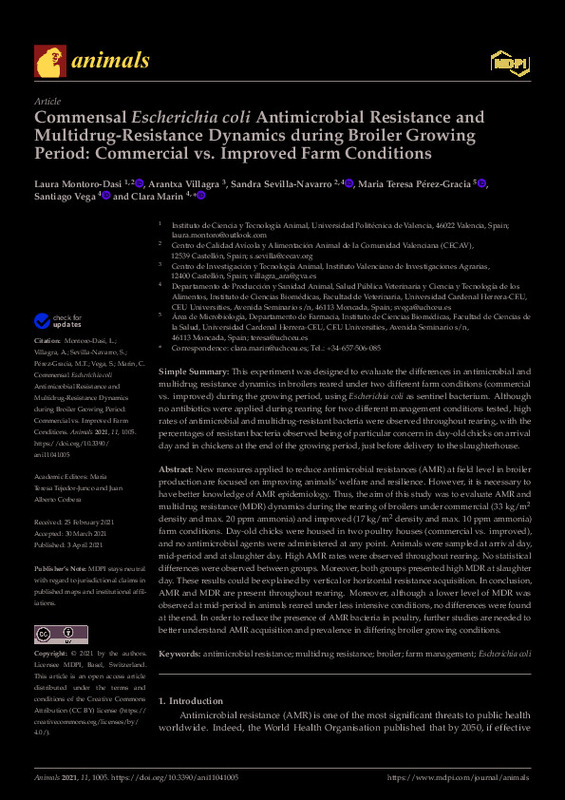JavaScript is disabled for your browser. Some features of this site may not work without it.
Buscar en RiuNet
Listar
Mi cuenta
Estadísticas
Ayuda RiuNet
Admin. UPV
Commensal Escherichia coli Antimicrobial Resistance and Multidrug-Resistance Dynamics during Broiler Growing Period: Commercial vs. Improved Farm Conditions
Mostrar el registro sencillo del ítem
Ficheros en el ítem
| dc.contributor.author | Montoro-Dasí, Laura
|
es_ES |
| dc.contributor.author | Villagrá, Arantxa
|
es_ES |
| dc.contributor.author | Sevilla-Navarro, Sandra
|
es_ES |
| dc.contributor.author | Pérez-Gracia, Maria Teresa
|
es_ES |
| dc.contributor.author | Vega, Santiago
|
es_ES |
| dc.contributor.author | Marin, Clara
|
es_ES |
| dc.date.accessioned | 2024-04-18T18:08:52Z | |
| dc.date.available | 2024-04-18T18:08:52Z | |
| dc.date.issued | 2021-04 | es_ES |
| dc.identifier.uri | http://hdl.handle.net/10251/203606 | |
| dc.description.abstract | [EN] New measures applied to reduce antimicrobial resistances (AMR) at field level in broiler production are focused on improving animals' welfare and resilience. However, it is necessary to have better knowledge of AMR epidemiology. Thus, the aim of this study was to evaluate AMR and multidrug resistance (MDR) dynamics during the rearing of broilers under commercial (33 kg/m2 density and max. 20 ppm ammonia) and improved (17 kg/m2 density and max. 10 ppm ammonia) farm conditions. Day-old chicks were housed in two poultry houses (commercial vs. improved), and no antimicrobial agents were administered at any point. Animals were sampled at arrival day, mid-period and at slaughter day. High AMR rates were observed throughout rearing. No statistical differences were observed between groups. Moreover, both groups presented high MDR at slaughter day. These results could be explained by vertical or horizontal resistance acquisition. In conclusion, AMR and MDR are present throughout rearing. Moreover, although a lower level of MDR was observed at mid-period in animals reared under less intensive conditions, no differences were found at the end. In order to reduce the presence of AMR bacteria in poultry, further studies are needed to better understand AMR acquisition and prevalence in differing broiler growing conditions. | es_ES |
| dc.description.sponsorship | This research was funded by the National Institute for Agricultural Research and Experimentation and the Ministry of Economy, Industry and Competitiveness (RTA 2017-00013, Programme: MINECO, Ministerio de Economía y Competitividad) and University CEU-UCH (INDI 19/20). | es_ES |
| dc.language | Inglés | es_ES |
| dc.publisher | MDPI AG | es_ES |
| dc.relation.ispartof | Animals | es_ES |
| dc.rights | Reconocimiento (by) | es_ES |
| dc.subject | Antimicrobial resistance | es_ES |
| dc.subject | Multidrug resistance | es_ES |
| dc.subject | Broiler | es_ES |
| dc.subject | Farm management | es_ES |
| dc.subject | Escherichia coli | es_ES |
| dc.title | Commensal Escherichia coli Antimicrobial Resistance and Multidrug-Resistance Dynamics during Broiler Growing Period: Commercial vs. Improved Farm Conditions | es_ES |
| dc.type | Artículo | es_ES |
| dc.identifier.doi | 10.3390/ani11041005 | es_ES |
| dc.relation.projectID | info:eu-repo/grantAgreement/MINECO//RTA 2017-00013/ | es_ES |
| dc.rights.accessRights | Abierto | es_ES |
| dc.description.bibliographicCitation | Montoro-Dasí, L.; Villagrá, A.; Sevilla-Navarro, S.; Pérez-Gracia, MT.; Vega, S.; Marin, C. (2021). Commensal Escherichia coli Antimicrobial Resistance and Multidrug-Resistance Dynamics during Broiler Growing Period: Commercial vs. Improved Farm Conditions. Animals. 11(4). https://doi.org/10.3390/ani11041005 | es_ES |
| dc.description.accrualMethod | S | es_ES |
| dc.relation.publisherversion | https://doi.org/10.3390/ani11041005 | es_ES |
| dc.type.version | info:eu-repo/semantics/publishedVersion | es_ES |
| dc.description.volume | 11 | es_ES |
| dc.description.issue | 4 | es_ES |
| dc.identifier.eissn | 2076-2615 | es_ES |
| dc.identifier.pmid | 33916657 | es_ES |
| dc.identifier.pmcid | PMC8066766 | es_ES |
| dc.relation.pasarela | S\432550 | es_ES |
| dc.contributor.funder | Ministerio de Economía y Competitividad | es_ES |








